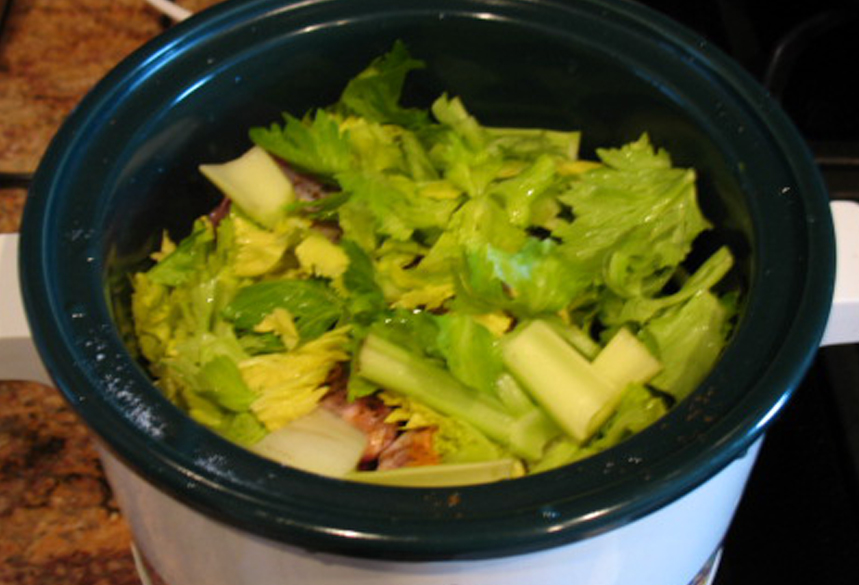
Reducing Food Waste in Foodservice
October 16, 2018 by Doreen Garelick, Dietetic Intern
Our intern Doreen attended a food waste summit for restaurants and compiled these tips to help food service operators redirect…
February 12, 2016

SPE's Dietetic Intern Charles Brewster, Jr. loves bone broth and likes to always have some on hand to drink and to use in cooking. In this blog, he shares his passion for this comfort food and advice if you want to make it at home.
While you may think bone broth is a trend from 2015 that’s here to stay in 2016, it’s actually been around for ages and cultures around the world consume broths regularly for health, wellness, and fertility. Our grandparents and great-grandparents might be proud to learn we’ve realized that something as simple and easy to make as bone broth (or soups made from bone broths or stocks) can be a fulfilling and nourishing part of our diet.
This list of purported benefits of bone broth is long and includes recovery from colds and flus, gut healing and digestive health, reduction of body inflammation, arthritis relief and additional protein (the building blocks of the body) from the gelatin and other amino acids. While there’s limited research about these potential benefits and the actual nutritional content of long-simmered bone broths, most can agree it’s one of the ultimate comfort foods. It’s a wonder more people aren’t drinking bone broth more regularly.
Making Bone Broth at Home
There are so many different ways to go about making this delicacy, but I will share what has worked in my experience. Bone broth can be made in anything that can simmer at a low temperature--crock pot, slow cooker, or large stock pot on the stove. I prefer a crock pot or slow cooker so I don’t have to worry about the temperature while the ingredients broth cooks as long as I like. (The longer the bones simmer, the richer the broth. You’ll be amazed how soft the bones become after being cooked for 24 hours!)
Personally, I believe that bone quality makes a difference and so I try to avoid conventionally raised animals that may have been given non-therapeutic antibiotics, hormones or were raised in poor living conditions. I tend to use organic chicken legs for my broths but you can also purchase bones from a local butcher or a farmers’ market, where you can ask the sellers how their animals are raised. While you can use bones that have been stripped of most of their meat, I like to use bones with the meat and skin still on them. For example, I add 5-6 chicken legs to my crock pot (bone, meat, and skin) and separate the meat and skin from the bones halfway through (I’ll reserve the meat that I removed, and either add the cooked meat back to the broth later or use it in another recipe).
You can include vegetables of your choice in your broth (such as celery, carrots, onions or string beans), as well as herbs and spices such as cilantro, parsley, turmeric, garlic, thyme and basil. Other important ingredients include a pinch of sea salt, black peppercorns (which may help increase the absorption and potency of the curcumin from the turmeric) and 1 to 2 teaspoons of apple cider vinegar or lemon (the acid helps break down the bones while being cooked).

Throw all the ingredients into your cooking vessel of choice, completely cover with water and simmer for anywhere from 12 – 28 hours. As it simmers, you can add more herbs and spices. You may also have to add water as it cooks down. Somewhere around the 18-hour mark, you can remove bones from the broth; they should have softened significantly at this point. To extract more of the gelatin and collagen from the bones into your broth, you can break up the bones for the final hours of cooking.
Sample the broth throughout the cooking process to taste how the flavor intensifies. At the end of the cooking process, you can adjust the seasoning to taste and the bones can be removed from the broth. The bones can be either discarded but I like to consume them on their own or sautéed in a pan with olive oil. Once the broth is cooled, strain the broth and allow it to cool. Once cool, you can store it in containers in the refrigerator for up to a week or the freezer for up to 3 months.
This is how I make bone broth at home but there are few set rules to making broth. Experiment, have fun, and enjoy!

October 16, 2018 by Doreen Garelick, Dietetic Intern
Our intern Doreen attended a food waste summit for restaurants and compiled these tips to help food service operators redirect food waste from landfills.
Nutrition 101

Nutrition 101
September 26, 2018 by Doreen Garelick, Dietetic Intern
Ever notice headlines about rapid weightloss? Dietetic Intern Doreen Garelick looks deeper into a recent eye-catching headline to see if there's any truth behind it.
Connect
 Follow us on Twitter
Follow us on Twitter Friend us on Facebook
Friend us on Facebook Follow us on Pinterest
Follow us on Pinterest Follow us on Instagram
Follow us on Instagram Read our Blog
Read our Blog Watch videos on YouTube
Watch videos on YouTube Watch videos on Vimeo
Watch videos on Vimeo Connect with us on Linkedin
Connect with us on Linkedin Find us on Foursquare
Find us on Foursquare
Tweets by @SPEcertifiedBlog Search
Categories
SPE Certified Newsletter
Sign up for news on the latest SPE-certified venues, events and SPE updates.
We will never share your personal information with a third party.